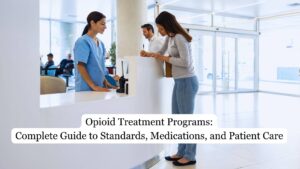Methadone is a long-acting prescription opioid used in two primary contexts, which include managing certain cases of chronic pain and treating opioid use disorder (OUD) as part of medication-assisted treatment (MAT).
This medicine is tightly regulated because of its powerful effects and significant risk profile. This article answers whether methadone is a controlled substance or not, and discusses its legal classification and the rules governing how it’s prescribed and dispensed.
What Is Methadone?
It is a long-acting, synthetic, full opioid agonist that binds to mu-opioid receptors. Its elimination half-life is long and variable, with commonly cited ranges of 8–59 hours, which supports once-daily dosing for OUD.
This medication has approved medical uses, including chronic pain management in select patients when the benefits outweigh the risks. It is also used for the treatment of OUD within professional programs, where it reduces withdrawal symptoms and cravings and stabilizes brain opioid receptors.
Analgesic effects may last 4 to 8 hours in opioid-tolerant individuals, while the medication’s blood levels persist longer, which is one reason careful dose adjustment and medical monitoring are essential.
Classification as a Controlled Substance
Methadone is listed as a Schedule II controlled substance under the U.S. Controlled Substances Act (CSA). This means it has accepted medical uses but also carries a high potential for misuse or dependence if not properly managed. Other medicines in the same category include oxycodone, morphine, fentanyl, hydromorphone, and certain stimulants like amphetamine and methylphenidate.
Because of this classification, this OUD medication is subject to strict legal controls. Prescriptions written for pain relief cannot be refilled automatically. Pharmacies and treatment programs must follow detailed rules for storage, record-keeping, and dispensing to prevent diversion or misuse.
Methadone treatment for opioid recovery is offered through certified programs, often with support and referral from doctors, counselors, or family.
Legal and Regulatory Oversight
The Food and Drug Administration (FDA) approves methadone products and their labeling, including boxed warnings that highlight serious risks such as respiratory depression and potentially dangerous drug interactions. The Drug Enforcement Administration (DEA) enforces the nation’s controlled-substance laws, ensuring that any organization handling the drug is registered, securely stores the medication, and maintains accurate records of inventory and patient dispensing.
When this prescription opioid is used to treat OUD, it can be dispensed only through federally certified and DEA-registered Opioid Treatment Programs (OTPs) under 42 CFR Part 8. Patients are given their daily methadone doses at certified clinics to ensure safety and adherence. If they demonstrate compliance with the program, they may be eligible to receive take-home doses. Recent federal updates have made some pandemic-era flexibilities permanent, allowing stable patients up to 28 days of take-home medication.
The duration of methadone treatment varies based on individual clinical needs, with some patients requiring short-term stabilization and others benefiting from long-term or even indefinite maintenance therapy to prevent relapse and support recovery.
DEA-registered healthcare providers can prescribe it as a pain reliever, and pharmacies can dispense it like other Schedule II drugs. However, methadone cannot be prescribed for opioid addiction outside of an OTP. Hospitals and emergency departments may only administer this drug for up to three days, often called the “three-day rule,” to manage withdrawal symptoms while arranging a patient’s transfer to a licensed treatment program.

Risks and Abuse Potential
Methadone, though effective for treating opioid use disorder and chronic pain, carries notable risks and a significant potential for abuse. Its long and variable half-life can lead to accumulation and overdose, particularly during dose adjustments or when combined with other depressants such as benzodiazepines or alcohol.
A major concern is respiratory depression, which can be fatal if not closely monitored. It may also cause cardiac arrhythmias, such as QT interval prolongation and torsades de pointes, a dangerous type of fast heart rhythm, at higher doses.
As a Schedule II controlled substance, it poses risks of misuse, diversion, and addiction, even when used therapeutically. Patients can develop physical dependence and tolerance, making careful dosing and tapering essential to prevent withdrawal or overdose. Drug interactions, sedation, and impaired cognitive function can compromise safety, particularly when driving or operating machinery.
Although take-home doses increase treatment accessibility, they heighten the risk of diversion if not securely managed. Persistent stigma and mismanagement further complicate safe methadone use, emphasizing the need for vigilant monitoring, patient education, and adherence to regulatory safeguards.
Final Thoughts from Raise the Bottom
Methadone is a Schedule II controlled substance in the United States and a tightly regulated medication internationally. In pain care, it follows standard Schedule II prescribing rules; for OUD, it must be dispensed through certified OTPs with close monitoring and carefully managed take-home privileges. While it carries real risks, those are mitigated through appropriate dosing, monitoring, and regulation.
At Raise the Bottom, our methadone program in Nampa, Idaho, operates in full compliance with federal regulations and Idaho healthcare standards, integrating the latest clinical guidelines into everyday care. Our multidisciplinary team delivers individualized assessments, ongoing dose optimization, and supportive services that promote safety, stability, and long‑term recovery. Patients receive coordinated, compassionate care designed to reduce harm, enhance quality of life, and help sustain recovery over time.






